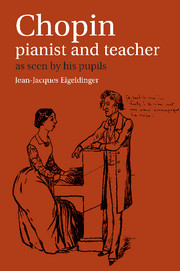Book contents
- Frontmatter
- Contents
- List of illustrations
- Acknowledgements
- Explanation of references
- Editor's note
- Abbreviations
- Introduction
- Part I Technique and style
- Part 2 Interpretation of Chopin's works
- Notes
- List of Chopin's pupils whose recollections are quoted in this book
- Appendix I Translated transcript of Chopin's ‘Sketch for a method’ (Projet de méthode)
- Appendix II Annotated scores belonging to pupils and associates of Chopin
- Appendix III Fingerings and annotations in the scores of pupils and associates
- Appendix IV Chopin's playing described by his contemporaries
- Bibliography
- Index of persons
- Index of musical works
Appendix IV - Chopin's playing described by his contemporaries
Published online by Cambridge University Press: 05 June 2014
- Frontmatter
- Contents
- List of illustrations
- Acknowledgements
- Explanation of references
- Editor's note
- Abbreviations
- Introduction
- Part I Technique and style
- Part 2 Interpretation of Chopin's works
- Notes
- List of Chopin's pupils whose recollections are quoted in this book
- Appendix I Translated transcript of Chopin's ‘Sketch for a method’ (Projet de méthode)
- Appendix II Annotated scores belonging to pupils and associates of Chopin
- Appendix III Fingerings and annotations in the scores of pupils and associates
- Appendix IV Chopin's playing described by his contemporaries
- Bibliography
- Index of persons
- Index of musical works
Summary
To complement the chapters on Chopin's teaching, the opportunity is taken here of quoting the main accounts of Chopin's own playing as described by his contemporaries: the teacher Chopin is indissolubly linked, after all, to the pianist, simply reflecting the latter in the didactic medium. The quotations are grouped under four headings, according to the categories (often flexible) to which their authors belong: Composers and Pianists; Pupils; Associates; Music Critics. Despite their diversity of date and origin, many of these accounts exhibit remarkable concordances, contributing generally towards a unified impression. Two sub-headings are entitled respectively ‘Chopin playing Beethoven’ (under Pupils) and ‘Chopin as improviser’ (under Associates). Liszt's main text on this subject has already been quoted virtually in its entirety (p. 51 above). The second main category of contributors is intentionally restricted here since it has already been the main subject of our book: it nevertheless includes passages which, except for a few fragments, have not been quoted above. The passages given in this Appendix may serve to fill out any somewhat mosaic feeling inherent in the main texts above, an unavoidable consequence of their reorganization of the source material. Here, however, the aim is purely descriptive; the texts are left to speak for themselves and for one another.
- Type
- Chapter
- Information
- Chopin: Pianist and TeacherAs Seen by his Pupils, pp. 267 - 296Publisher: Cambridge University PressPrint publication year: 1987



